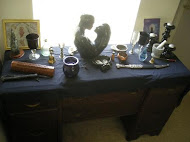* History And Origins Of Imbolc *
Compiled By Meredith
Imbolc is one of the four greater Sabbats. Most traditions celebrate it on February 1st or 2nd, or on the first Full Moon in Aquarius. Other names for Imbolc, include; Brigantia (Day of Brigid, England), Candlearia (Mexican Craft), Feast of the Waxing Light (unknown), Disting-id (Teutonic), Candlemas (Christian, The Purification of the Virgin), St. Brigid's Day (Irish), Oimelc (ewe-milk, Celtic), Lupercus or Lupercalia (Feast of Pan, Roman/Strega), Fest of Lights (unknown), Antihestria (Greek, for the Festival of Flowers), and in our culture Groundhog Day. Some contributed meanings to the word Imbolc are "in the belly" or "in milk" and refers to the pregnancy and lactation of the ewes. This Sabbat is a celebration of Spring’s coming, and an end to the dark, cold days of Winter. In Celtic traditions, this is a holiday associated with Brigit, and has survived to this day in Ireland as St Bridget's Day. (Who was reputedly a midwife at the birth of Christ.)
The Romans dedicated the holiday to Venus and Pan, and the Greeks to Diana. In Norse traditions it was known as Disting-id and was a time for readying the Earth for planting, usually by sprinkling it with ashes, salt, and herbs. Candlemas rituals, are done by Catholics. Some of whom bring their candles for the coming year to the church to be blessed by a priest. Americans celebrate Groundhog's Day, where we find what our chances of an early spring will be.
Imbolc is traditionally a time of new beginnings, with planning, starting over, and making way for the new. In our modern lives the season has little impact on our daily life. But for our ancestors it would have been very different. In the northern hemisphere the ground is often still covered with snow at this point, and might have been too hard to till and prepare yet for spring planting. Our ancestors would have been living off of their stores from the previous harvest. This would have been a time of reflection and looking back, evaluating the stores they had put by, wondering if there would be enough, and at the resolutions that had been made. Being mostly house bound this was the best time for working on things for the house. Sitting in front of the cook fire while the stew simmered and working on a quilt, dipping candles from the tallow in the stores, making the small repairs which they would be too busy to perform during the growing season.
Traditions
Bread spread with butter was left on window sills on Imbolc Eve as a gift for the Lady, who was thought to visit each household that night, along with an ear of corn for her white cow. For those a bit more modern, try leaving buttered bread, an ear of corn, and a saucer of milk for Brigid on your doorstep. Reputedly butter and butter churns are sacred to Brigit. Sometimes the handle of the churn dash was turned upside-down and stuck into the ground with a cake placed on the flat top. In Scotland, on the last day of January, the ladies of the household would dress a corn dolly or a sheaf of oats (fertility) in woman's clothes and lay it in a basket or on a pile of reeds called a "Bride's Bed" next to the fireplace. A club, rod, or wand (often with a pine cone tip) was laid next to the doll. The women would then call out three times
"Bride is come! Bride is welcome!"
and discreetly withdraw so that the phallic "God" would impregnate the "Goddess." When the night was over, the women returned and checked the ashes of the fireplace or some type of sign. This could be the imprint of the club in the ashes, a footprint or any other mysterious symbol. If they find one, the coming year will be fruitful.
Decorations
Decorate your Imbolc altar with Goddess images, lights, and candles, as this is a Sabbat associated with light. Set out a bowl of snow to slowly thaw and remind you of the approaching spring. Corn dolls are also appropriate, as are seeds and any sprigs of early-sprouting plants you can find. Imbolc is a festival of the home and hearth, and you can keep a fire in your fireplace all day or a small fire burning in a cauldron on your altar. Now is also a good time to buy new plants for your house.
Herbs
Snowdrop, Bay, Heather, First Flower of the Year.
Incense
Rosemary, Cinnamon, Wisteria Frankincense, Myrrh, Basil, Jasmine, Camphor, Lotus
Colors
Black, White, Pink, Green, Orange, Red.
Food
Dairy products, Salmon, Lamb, Pork, Sprouts, Eggs, Spicy foods such as Curries and peppers, onions, Chives, Spiced wines, Seeds, Herbal teas, and round foods.
Gemstones
Amethyst, garnet, onyx and turquoise
Spellwork
Catalyst spells, spells for beginnings, rejuvenation spells, purification spells, spells for good luck and for future endeavors, and initiatory rites.
Totem Animals
Wolves, Bears, Stags, Eagle, Raven, Groundhog
Poems
This medieval Anglo-Saxon plowing charm, recorded by Berger, was said by the farmer while cutting the first furrow.
Whole be thou Earth
Mother of men.
In the lap of God,
Be thou as-growing.
Be filled with fodder
For fare-need of men.
The farmer then took a loaf of bread, kneaded it with milk and holy water and laid it under the first furrow, saying:
Acre full fed,
Bring forth fodder for men!
Blossoming brightly,
Blessed become;
And the God who wrought the ground,
Grant us the gifts of growing,
That the corn, all the corn,
May come unto our need.
If Candlemas day be fair and bright,
Winter will have another flight
If Candlemas day be clouds and rain,
Winter is gone, and will not come again.
~E. Holden
* Ideas To Celebrate Imbolc *
Compiled By Meredith
Homemade Butter - In memory of our ancestors, and devoting your efforts to Brigit, you and your family can take turns making homemade butter. You will need;
- 1/2 pint whipping cream
- A jar with a tight-fitting lid.
Fill the jar 1/3 1/2 full of cream. Screw the lid on tightly and begin shaking the jar or rolling it back and forth on the floor or table top. The cream will begin to thicken and then small pieces of butter will begin to form. Continue shaking or rolling the jar until the butter forms a solid mass separate from the thin buttermilk. (It should take 10-15 minutes) You may add a dash of salt if you wish. The butter may be formed into different shapes using small cake molds or cookie cutters. Sample the butter on crackers or steamed vegetables Remember to keep any left-over butter refrigerated..
Spring Search - Take a hike with friends or family. Be on the lookout for signs of spring. Take souvenirs home, such as acorns, rocks, sticks etc. to make wands with.
Make a Priapic Wand - Take a stick about a foot long, and affix an acorn or pinecone to the tip with glue, wire, or twine. Use it in your Imbolc celebrations, and put it to "bed" with your corn doll.
Corn Dolls - Corn dolls, traditional portrayals of the Maiden, are common symbols of Imbolc. Dried stalks of wheat and grass can be found cheaply at craft stores. Tying a sheaf of wheat in three places, to represent the Triple Goddess, and wrapping it in a lace hanky can make simple corn dolls. To make a more complicated doll, bend the sheaf in half, tying it an inch or so below the bend. Make a small braid and poke it through just below the tie to serve as arms. Tie it again to mark the waist. Spread the ends of the sheaf out as a skirt, draping it over a cardboard cone if necessary to give it support. You can decorate it further as you wish, with a small straw hat, flowers or leaves, or just leave it plain.
Spring Cleaning - When you've completed your Spring-cleaning don't toss your old clothes and such, donate them to a local shelter for example. Go through your cupboards and donate canned foods or hold a canned food drive in your community.
Make Some Noise - Wake up early in the morning, take out all the noisemakers you can: pots and pans and whistles, go outside and joyfully make noise to wake up the sleeping Mother Earth. Bang away, wake her up! Little kids love a reason to let loose. Be nice to your neighbors though!
Planting rituals - You could also hold a ritual blessing over the seeds you plan to use in this year's garden.
Candle Making - Make and bless candles for the year to come. Children will enjoy helping you make candles. Wax can be purchased at your local craft store, in sheets or in blocks. Sheets are safest to use with small children, as no heat is involved. The sheets are simply rolled around long wicks. For older kids, melt the wax in a double boiler over low heat, or in a large empty can, with it's paper wrapping removed. Dip the wicks in one at a time, let the wax to harden before you dip again. You can use orange juice cans or milk cartons as molds. Wash them, then attach a length of wick to a pencil and allow it to hang inside the mold. Pour in the wax, and when it is cool and dry, remove the pencil and peel off the cardboard. Candles can be decorated, with whatever you would like, by pressing the objects into the wax while it is still slightly warm. You could also add scented oils, in small quantities, to your candles.
Fire - Clean your fireplace, sweeping clear all the ashes, then bless your hearth, and light a fire. Have an outdoor bonfire ritual, as a reminder of the warmth of spring to come. This would also be a good time to burn any Yule greens that still remain.
Bride's Crosses - In Ireland, people make Bride's Crosses woven of rushes or withies and in the shape of a three or four-armed cross. Or if you don't have these items, weave a Bride's cross out of wheat or barley purchased from the craft store or one out of the local grasses with dried seed heads. This custom may derive from an earlier fire ceremony in which this cross would have been ignited and cast into the winter skies of February to hasten the coming spring.
Dance the Spiral Dance! - Spiral dances are always fun. Grab hands and snake through the grass or the living room, wherever you do your ceremony. For those who cannot or do not want to do spiral dance, this is an excellent time to participate in the rhythm, by beating drums, shaking maracas and rolling rattles.
Disclaimer: No one involved in this blog or its contents may be held responsible for any adverse reactions arising from following any of the instructions/recipes on this list. It is the reader's personal responsibility to exercise all precautions and use his or her own discretion if following any instructions or advice from this blog.















No comments:
Post a Comment